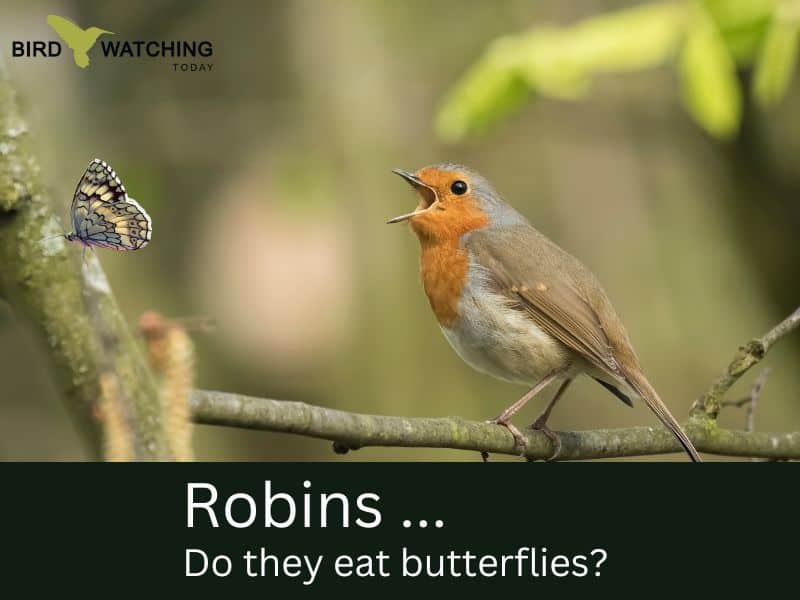Robins are one of the most recognizable birds in North America and have a diet to match their friendly demeanor. As omnivores, they will eat both plants and animals to get the nutrients they need.
Earthworms, caterpillars, and beetles are a few popular animal items on Robins’ menu. But, as opportunistic eaters, they eat quite strange animals than that. So, do they eat butterflies as well?
Yes. Robins eat butterflies. But, butterflies are at the very bottom of their preferred meals. If other animal food that they prefer such as earthworms are available in their feeding grounds, robins would not feast on butterflies.
So, you would not easily see a robin eating a butterfly. Here is footage of a robin catching a butterfly and eating it.
Robins eat butterflies! But, are there any butterflies they don’t eat?
In general, there are certain types of butterflies that birds deliberately avoid feeding on them. One such butterfly is the monarch butterfly.
Monarch butterflies are beautiful, majestic creatures that people around the world admire and enjoy. It may seem strange that these delicate brightly colored insects can survive in a world full of predators, but monarchs have evolved a powerful defense mechanism to protect themselves from harm.
It all starts with their diet! Monarchs feed exclusively on milkweed plants which contain a toxic substance called a cardiac glycoside. This chemical is poisonous to most animals, including birds, so when Monarch butterflies ingest it, they become toxic and distasteful as well. It makes birds vomit.
The bright colors of their wings also act as a warning signal (aposematic coloration) for any predator that may try to attack them –butterflies are usually brightly colored when they are toxic or foul-tasting!
In addition to these truly toxic butterflies, some non-toxic butterflies also mimic toxic ones with brightly colored wings. Since birds tend to avoid those bright colors, it is a good defensive mechanism for non-toxic ones as well.
So, robins also tend to avoid eating toxic butterflies such as monarch butterflies and other mimicking ones so that they do not get into unnecessary trouble with this less interesting meal.
Do robins eat moths?
The moth population is about nine times that of the butterflies. They both belong to the Lepidoptera order of insects which includes more than 180,000 species.
Hence, it seems there’s a high chance of robins eating moths than butterflies. But it is not completely true. Though butterflies and moths look quite similar, they have some interesting differences.
- Mostly, moths are nocturnal (active at night) while butterflies are primarily diurnal (active in the daytime).
- Moths have drag-colored wings that help them at night to camouflage with dark environments. But butterflies have bright color wings.
- Moths are comparatively smaller and sturdier and have furry bodies while butterflies are larger with lean and smooth bodies (but, note that there are a few larger moths and very small butterflies)
Since robins feed in the daytime, nocturnal moths can not be considered a suitable item to include in the robin’s diet. But, as opportunistic eaters, they would eat day-flying moths when they are in need of extra protein and the supply is short from other animals.
What is robin’s main diet? What do they eat on regular basis?
One of the robin’s favorite meals (if not the most favorite) is earthworms! Robins will often go out early in the morning, when worms are closer to the surface of the soil, and snatch them up with their beaks. They also feast on caterpillars, grubs, beetles, and other bugs that live close to the ground.
Robins also enjoy a variety of fruits such as berries, grapes, and cherries. Some may even venture into suburban neighborhoods for these treats when their natural habitats don’t provide enough food. As long as there is something tasty available for them to consume, you can count on seeing robins around your house!
Can robins and butterflies coexist in the same garden? What makes them regularly visit your garden?
Since robins are predators of butterflies, they can not exactly coexist with each other similar to hummingbirds and butterflies. But you can attract both of these creatures to your garden if you prepare your garden and feeder set-ups to attract them.
Firstly, when it comes to robins, they regularly visit places where food is available. So, provide what they are looking for. Here are things you can do.
- Plant berry bushes, cherry trees, and other native fruit plants that robins attracted in your garden so that it becomes a natural feeding ground for them.
- Since robins are ground feeders, you can set up ground feeding trays or feeding tables and fill the feeders with suet, bird seeds, peanut hearts, and other fruits such as apple slices, etc.
- Provide fresh water so they can hydrate when they visit your garden
- Avoid or reduce using insecticides so that birds will keep coming for insects and naturally control the insect population.
So, how to attract butterflies to your garden?
- Butterflies are attracted to bright color flowers. Plant more flowering plants in your garden.
- Butterflies need host plants to lay their eggs. These host plants feed their caterpillars. So, having host plants in shady areas of your garden is one of the best ways to keep butterflies attracted.
- Set up hanging nectar feeders for butterflies.
Wrapping up…
Regular visits of both robins and butterflies make our gardens fascinating. But, similar to some other birds, do robins also eat butterflies?
Yes. Robins eat butterflies. However, there are plenty of other animals that robins prefer over butterflies. Earthworms, caterpillars, and beetles are a few of their favorite animal food. However, they are omnivores and animals cover only about half of what they eat.




